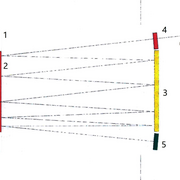’Seed beam scanning’ – more powerful ultra-short-pulsed disk lasers (USP lasers) thanks to compact multipass amplifier
Abstract
Instead of letting the seed beam cross the pump spot as often as 80 times, now a much smaller seed beam can be used for gridding the pump spot, leading to a higher laser performance.
Advantages
- Increased output power
- Compact and cost-effective
- Mechanically and thermally stable thanks to short beam path
- Significantly smaller but more efficient seed beam at the same or lower power density
- Principle also applicable to oscillators
Fields of application
The invention developed at the 'Institut für Strahlwerkzeuge' (Universität Stuttgart) now offers a method for further increasing the output power of (USP) disk lasers by scanning the pump spot with a much smaller seed beam. The result: A more compact, robust and cost-effective solution, offering a significant increase in disk laser performance.
Background
The performance of disk lasers, which were introduced more than 25 years ago, is still being improved in order to meet the demands for higher productivity in machining processes. However, upscaling within established systems will at some point reach physical limits. The maximum usable power density of the pump laser beam is limited by quantum defects and the associated heating of the laser medium. The overall performance can therefore only be increased by more efficient use of the seed beam itself.
Problem
To fold a seed beam, with the same size as the pump spot, over that spot as often as possible, a large number of mirror elements have been used up to now. These are arranged around the laser disk and can be adjusted individually. However, this amplifier setup, achieving a maximum output power of 2 kW, makes the system rather bulky and system adjustment is quite complex. The individual optical elements are also very expensive. In addition, the long beam paths between the various components result in stability issues due to thermal effects.
Solution
By intelligently configuring a few optical components (at least one mirror and two retroreflectors) and by using the parallel offset between the incident and outgoing beams caused by retroreflectors, it is possible to scan the pump spot with a seed beam having a much smaller diameter. This setup allows using a pump spot of typical or even larger size. With a small seed beam (Ø ≈ 1 mm) it is possible to achieve the required saturation intensity in the disk, maintaining the same average power density with a single pass. Instead of crossing a pump spot 80 times using a large, comparatively inefficient beam, this method allows a corresponding area of the laser medium to be scanned with more efficient beam power within the same period of time. This configuration not only offers further economic advantages, but also an increase in USP laser performance.

![Fig 1: Schematic diagram of the beam position or grid sequence on the pump spot.
1 – disk, 2 – pump spot, 3 – Mirror, 4 – retroreflector I, 5 – retroreflector II, 6 – outcoupling. [Source: Institute for Blasting Tools; University of Stutttgart] Fig 1: Schematic diagram of the beam position or grid sequence on the pump spot. 1 – disk, 2 – pump spot, 3 – Mirror, 4 – retroreflector I, 5 – retroreflector II, 6 – outcoupling. [Source: Institute for Blasting Tools; University of Stutttgart]](/fileadmin/_processed_/8/2/csm_17_038_HP-Abb1_Raster_8e6279af67.png)
